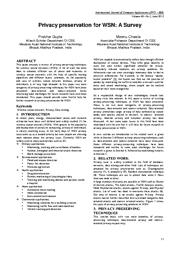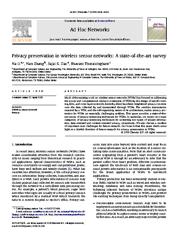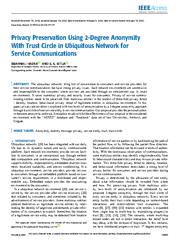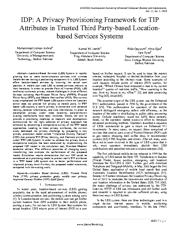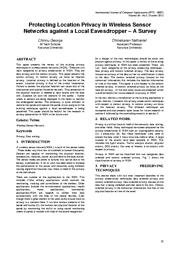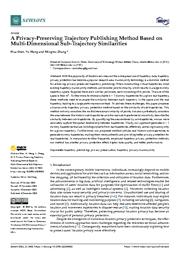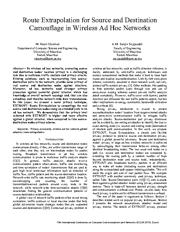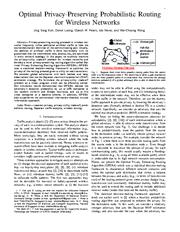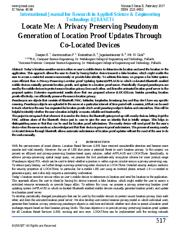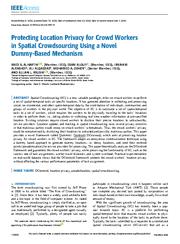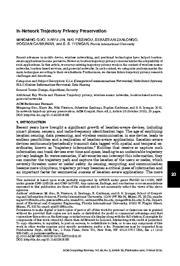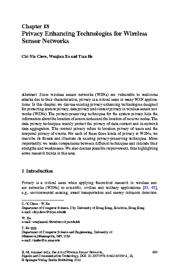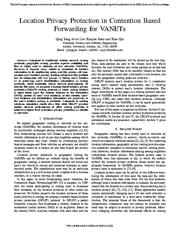A copy of this work was available on the public web and has been preserved in the Wayback Machine. The capture dates from 2017; you can also visit the original URL.
The file type is application/pdf.
Filters
Privacy preservation for WSN: A Survey
2012
International Journal of Computer Applications
This paper presents a review of privacy-preserving techniques for wireless sensor networks (WSN). ...
Some interesting open challenges for future research have also been introduced. This paper should provide some fruitful help for further research in privacy preservation for WSN. ...
)
Huge
No extra delay
No extra
power
consume
Injects a
dummy
packet for
uniform
sending rate
Excellent (For
base station
privacy)
No
extra
over-
head
No extra delay
Fair but
decreases ...
doi:10.5120/7326-0159
fatcat:cpowbksth5bkxk4i4emu67dpfa
Privacy preservation in wireless sensor networks: A state-of-the-art survey
2009
Ad hoc networks
This paper provides a state-of-theart survey of privacy-preserving techniques for WSNs. ...
We also discuss a number of important open challenges for future research. Our hope is that this paper sheds some light on a fruitful direction of future research for privacy preservation in WSNs. ...
For the first class privacy, a straight forward approach to defend against internal adversaries is to apply end-to-end encryption between the data source and the base station. ...
doi:10.1016/j.adhoc.2009.04.009
fatcat:v2daasfks5dijhqnledvfjdcgy
Rate-Privacy in Wireless Sensor Networks
[article]
2013
arXiv
pre-print
Our discussion reveals that the concept indeed is of a great importance for the privacy preservation of such networks. As a result, we propose a buffering scheme to protect the rate from adversaries. ...
This paper introduces the concept of rate privacy in the context of wireless sensor networks. ...
Motivated by the shortcomings of the approaches described above, we present a rate-privacy preservation scheme as follows. ...
arXiv:1302.1506v1
fatcat:ztlmy7qqlnfpvgeeyqrpgy4at4
Privacy Preservation using 2-Degree Anonymity with Trust Circle in Ubiquitous Network for Service Communications
2020
IEEE Access
In this paper, privacy preservation is explored with two levels of anonymization by a 2-degree anonymity approach through trust circle of one service entity in service communication. ...
It raises numerous privacy and security issues for consumers. ...
Many privacy preservation approaches are proposed for different environments. The cryptographic approach is one of the traditional privacy preservation techniques. ...
doi:10.1109/access.2020.2971239
fatcat:fwinofqj5fbn3bgcsdz5itxn34
IDP: A Privacy Provisioning Framework for TIP Attributes in Trusted Third Party-based Location-based Services Systems
2020
International Journal of Advanced Computer Science and Applications
Hence, the aim to provide a promising roadmap to research and development communities for the right selection of privacy approach has achieved by conducting a comparative survey of the TTP based approaches ...
Leading to these privacy attributes, the current study addressed the privacy challenge by proposing a new privacy protection model named "Improved Dummy Position" (IDP) that protects TIP (Time, Identity ...
Kamal m Jambi for technical and financial support in this research. ...
doi:10.14569/ijacsa.2020.0110773
fatcat:adq2jv6rlzgkppbcp52rwue3ru
Protecting Location Privacy in Wireless Sensor Networks against a Local Eavesdropper A Survey
2012
International Journal of Computer Applications
So an analysis of the existing techniques against a local eavesdropper is being presented. This paper should be helpful for the research in privacy preservation in WSN in the future work. ...
This paper presents the review of the existing privacy techniques in wireless sensor networks (WSN). There are two main categories of privacy preservation in WSN. ...
In the next section a introduction to the existing approaches is given. Section 3 presents the privacy preservation techniques with respect to context privacy. ...
doi:10.5120/8888-2889
fatcat:eopsxnlglzfaxat35o3hmtplze
A Privacy-Preserving Trajectory Publishing Method Based on Multi-Dimensional Sub-Trajectory Similarities
2023
Sensors
Finally, our approach generates k−1 dummy trajectories that are indistinguishable from real trajectories, effectively achieving k-anonymity for a given trajectory. ...
privacy-preserved trajectory publishing. ...
[42] primarily constrained the geographic location of trajectories and introduced a privacy-preserving method for measuring distance-based trajectory similarity. ...
doi:10.3390/s23249652
pmid:38139504
pmcid:PMC10747896
fatcat:54sosv7ac5e7jhurdu6t6kco6i
Route Extrapolation for Source and Destination Camouflage in Wireless Ad Hoc Networks
[article]
2012
arXiv
pre-print
In wireless ad hoc networks, protecting source and destination nodes location privacy is a challenging task due to malicious traffic analysis and privacy attacks. ...
We demonstrate that the privacy level achieved with EXTROUT is higher and more effective against a global attacker, when compared to fake source destination nodes privacy scheme. ...
Compared to other techniques in the literature, the EXTROUT preserves the privacy for uplink and downlink traffic of nodes.
A. ...
arXiv:1208.5569v1
fatcat:ekaqwsiokrc5jcyzuced4hb7he
Optimal Privacy-Preserving Probabilistic Routing for Wireless Networks
2017
IEEE Transactions on Information Forensics and Security
In this paper, we explicitly examine the privacy-utility trade-off problem for wireless networks and develop a novel privacy-preserving routing algorithm called Optimal Privacy Enhancing Routing Algorithm ...
Privacy-preserving routing protocols in wireless networks frequently utilize additional artificial traffic to hide the source-destination identities of the communicating pair. ...
Therefore, we use the dummy traffic approach to provide privacy by lowering the adversary's detection rates (formally defined in Section III) in a wireless network. ...
doi:10.1109/tifs.2017.2698424
fatcat:63njeikpevesxlrus6ce2yfepq
Evolution of Privacy Preservation Models in Location-Based Services
2020
Advances in Science, Technology and Engineering Systems
This work presents a detailed study on the evolution of existing privacy preservation models need to preserve privacy, and the opportunities to integrate fog computing services into privacy architectures ...
The study proposes a fog integrated privacy preservation model exploring the benefits and open research issues in traditional models and recent integrated fog models. ...
in the privacy preservation approaches. ...
doi:10.25046/aj050311
fatcat:4g4bxgpl7vbapcxcpofwkgt2ce
Locate Me: A Privacy Preserving Pseudonym Generation of Location Proof Updates Through Co-Located Devices
2017
International Journal for Research in Applied Science and Engineering Technology
Extensive experimental results show that our proposed scheme (LOCATEme), besides providing location proofs effectively, can efficiently preserve the source location privacy. ...
To address this issue, we propose a far better system, more efficient than A Privacy-Preserving LocAtion proof Updating System(APPLAUS) in which co-located Bluetooth enabled mobile devices mutually generate ...
a position is within a given circular area in a privacy-preserving way. ...
doi:10.22214/ijraset.2017.2075
fatcat:45gjfkhtm5afbdr5v6sgn4yrqy
Protecting Location Privacy for Crowd Workers in Spatial Crowdsourcing Using a Novel Dummy-based Mechanism
2020
IEEE Access
This paper provides a novel framework called Dummies' Centroid (DCentroid), which aims at preserving location privacy for crowd workers in SC. ...
The framework adapts an anonymous communication technique using a dummy based approach to generate dummy locations, i.e. decoy locations, and send their centroid points (pseudolocations) to service providers ...
DCentroid: LOCATION PRIVACY PROTECTION TECHNIQUE DCentroid is a new introduced approach that is motivated by the dummy based technique to achieve location privacy for crowd workers in SC [31] . ...
doi:10.1109/access.2020.3004470
fatcat:7a32av66hbasxc6ioakd6o6xra
In-Network Trajectory Privacy Preservation
2015
ACM Computing Surveys
In this article, we survey existing trajectory privacy work in the context of wireless sensor networks, location-based services, and geosocial networks. ...
Furthermore, we discuss future trajectory privacy research challenges and directions. ...
Dummy Traffic Injection. Dummy traffic injection is another widely used technique to preserve source location privacy in sWSNs. ...
doi:10.1145/2818183
fatcat:hgc33wgqlrdnpll6bodpe7y5mm
Privacy Enhancing Technologies for Wireless Sensor Networks
[chapter]
2013
Signals and Communication Technology
The privacy-preserving techniques for the system privacy hide the information about the location of source nodes and the location of receiver nodes. ...
Due to these limitations, it is very challenging to design secure privacy-preserving techniques for WSNs. ...
Privacy-preserving techniques designed for protecting data source and base station privacy may prevent such malicious attacks. ...
doi:10.1007/978-3-642-40009-4_18
fatcat:acvd2cqeojazrk74x7jllyvpj4
Location Privacy Protection in Contention Based Forwarding for VANETs
2010
2010 IEEE Global Telecommunications Conference GLOBECOM 2010
To address this issue, we proposed a dummy-based location privacy protection (DBLPP) routing protocol, in which routing decision is made based upon the dummy distance to the destination (DOD), instead ...
In this scheme, users' true locations and identification information are preserved, so the user's location privacy is protected. ...
To further preserve the location privacies of those nodes involved in routing, we propose a dummy-based location privacy protection (DBLPP) protocol. ...
doi:10.1109/glocom.2010.5684166
dblp:conf/globecom/YangLRQ10
fatcat:5wu2hqzfbrglrnauspu3vao7yy
« Previous
Showing results 1 — 15 out of 4,568 results

